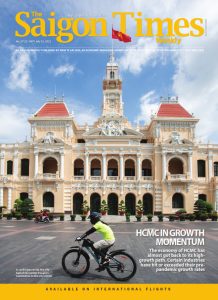The HCMC government has set a target of building 93,000 new social homes in the next 10 years, creating good business opportunities for many companies in the industry. However, there is a lot of work to be done to achieve the target.
At the end of last year, Secretary of the HCMC Party Committee Nguyen Van Nen shared with voters that the city’s first plan after the pandemic was to build social housing for the needy. The plan was put into action quickly after the housing development program in the city got approved in the sixth plenary session of the 10th tenure People’s Council of HCMC.
This showed that HCMC had paid great attention to building social and commercial housing for low-income people to stabilize the society and economy after two years of the pandemic. It was announced that HCMC would spend VND12,410 billion building 93,000 social housing units in the next 10 years.
Positive signs for housing supply
The social housing segment has become highly competitive after HCMC adopted many housing policies in favor of low-income people, including the housing development program for the 2021-2025 period. Approved by the People’s Council of HCMC, this program has created many favorable conditions for the development of this segment. In addition to solving the problem of land use rights, simplifying the investment procedure is another vital factor to improve the housing supply in the near future.
The positive signs of the HCMC housing development program have created a driving force for many enterprises to compete with each other in building social housing for low-income people. Since the beginning of 2022, several big enterprises announced their plans to develop affordable housing projects.
At the recent annual general meeting, Vingroup shared its plan to launch some 500,000 social housing units, branded Happy Home, with a selling price of VND300-950 million for each apartment. Those projects are expected to be completed in the next five years.
Before that, three big enterprises, consisting of Hung Thinh Corp., Dong Tam Group and Truong Thanh Furniture Corp., joined hands to build millions of affordable housing units in HCMC, Long An, Binh Duong, and Dong Nai. They announced the price would be around VND20 million per square meter or even cheaper with some financial support policies.
The main motivation for many investors to return to this housing segment comes from the Government’s Decree 49/2021. Decree 49 has added a number of preferential policies for relevant enterprises. In particular, the investors of social housing projects are exempted from land use levies and land rents for land allocated or leased out by the Government.
“When we’re exempted from land use levies and entitled to build as many small apartments as possible, the price of each unit is under our control and reasonable for low-income people,” Chairman of Vinhomes JCS Pham Thieu Hoa said.
Another reason why many investors pay much attention to the social housing segment is the ability to get credit. Commercial banks nationwide are tightening credit for investment in high-end real estate due to concerns about a virtual fever in property prices. However, good projects are still able to get credit or low-interest loans.
Perhaps, social housing is a good choice for many investors to maintain cash flow during this period.
How to achieve the planned targets
Housing programs, especially social housing, are often affected by market factors. In order to achieve the planned targets of these programs which are to fulfill the housing needs and ensure social security, there’s a need for improvement of administrative procedures, land use and management.
Strategic managers could learn from the mistakes of the recent programs and look deep into the price movement to come up with a reasonable monitoring mechanism.
The policy of social housing and the housing-land fund for the commercial housing projects in HCMC was established a long time ago.
Nearly 20 years ago, the low-income housing programs under Directive 07/2003 required that investors in housing construction projects must use 10% of the land fund for construction or 20% of the commercial housing fund on the principle of capital preservation (with audit).

According to Decree 188/2013, commercial housing projects with a land area of 10 hectares or more have to set aside at least 20% of the area to build social homes. The investors of BT and BOT with commercial housing projects must comply with the regulations. When they hand over the land fund for social housing to the government, they will be reimbursed for compensation and infrastructure construction costs.
However, while the commercial housing segment has grown at a high rate, the social housing one is lagging.
According to a report from the Department of Construction, there were 125,000 commercial housing units available for sale in the 2015-2019 period. For the social housing segment, only 15,177 apartments were built in the 2016-2020 period, reaching 75.89% of the planned target.
Many experts believe that the People’s Council of HCMC should carry out a resolution on the supervision of social housing programs, focusing on the key issues that need to be solved. During the recent meeting of the People’s Council, many resolutions related to the housing program were approved. These included the resolution on monitoring the implementation of social housing, which created great expectations for the development of the programs. Effective supervision will help increase the supply of social housing and create homeownership opportunities for low-income people.











